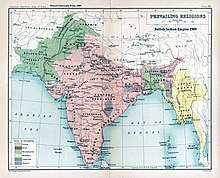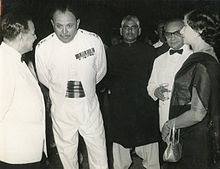History of East Pakistan
Nevertheless, adult education centres were opened in East Pakistan to train Bengalis into learning their mother tongue devoid of Sanskrit loanwords (which were condemned as kafir influence) & written in Nastaliq script.
The police reacted by firing on the crowd and killing many students, most of whom remain unidentified to this day (a memorial, the Shaheed Minar, was built later to commemorate the martyrs of the language movement).
The government machinery established at independence was similar to the viceregal system that had prevailed in the pre-independence period and placed no formal limitations on Jinnah's constitutional powers.
Out of necessity he considered the wishes of the country's premier religious spokesman, Syed Abul Ala Maududi, Amir of the Jamaat-e-Islami who championed the cause of Pakistan as an Islamic state.
He was seeking a balance of Islam against secularism for a new constitution when he was assassinated on October 16, 1951, by fanatics opposed to Liaquat's refusal to wage war against India.
Ghulam Mohammad was dissatisfied with Nazimuddin's inability to deal with Bengali agitation for provincial autonomy and worked to expand his own power base.
East Pakistan favored a high degree of autonomy, with the central government controlling little more than foreign affairs, defense, communications, and currency.
Prime Minister Bogra tried to limit the powers of Governor General Ghulam Mohammad through hastily adopted amendments to the de facto constitution, the Government of India Act of 1935.
Bogra, who had little support in the new assembly, fell in August and was replaced by Choudhry; Ghulam Mohammad, plagued by poor health, was succeeded as governor general in September 1955 by Mirza.
[2] Legislative election held from March 8 to 12, 1954, the United Front, a political coalition anchored by A. K. Fazlul Huq's Krishak Sramik Samajbadi Dal (Peasants and Workers Socialist Party) and the Awami League (People's League) led by Huseyn Shaheed Suhrawardy, won 223[8] out of 237 Muslim seats (total 309 seats) in East Bengal Legislative Assembly.
But on 30 May 1954 the governor-general of Pakistan Ghulam Mohammad[citation needed] dismissed the United Front government,[10] upon of accusations against A. K. Fazlul Huq of attempting secession.
From 1954 to Ayub's assumption of power in 1958, the Krishak Sramik and the Awami League waged a ceaseless battle for control of East Pakistan's provincial government.
He, like other Bengali politicians, was chosen by the central government to serve as a symbol of unity, but he failed to secure significant support from West Pakistani power brokers.
Moreover, his open advocacy of votes of confidence from the Constituent Assembly as the proper means of forming governments aroused the suspicions of President Mirza.
[2] On October 7, 1958, Iskander Mirza issued a proclamation that abolished political parties, abrogated the two-year-old constitution, and placed the country under martial law.
It was, instead, a document that buttressed centralized government under the guise of "basic democracies" programs, gave legal support to martial law, and turned parliamentary bodies into forums for debate.
The death of the Awami League's Suhrawardy in 1963 gave the mercurial Sheikh Mujibur Rahman (commonly known as Mujib) the leadership of East Pakistan's dominant party.
[11] Deadly campaigns of ethnic cleansing of Hindus broke out in East Pakistan in 1964 over fake news spread by the Ayub Khan regime that Indian forces had desecrated the Hazratbal shrine of Srinagar in the disputed state of Kashmir, stealing the enshrined relic of the Islamic prophet Muhammad's hair in process.
As late as 1960, approximately 70% of Pakistan's export earnings originated in the East Wing, although this percentage declined as international demand for jute dwindled.
[11] At a 1966 Lahore conference of both the eastern and the western chapters of the Awami League, Mujib announced his six-point political and economic program (on 5 February) for East Pakistani provincial autonomy.
On November 12, 1970, a cyclone devastated an area of almost 8,000 square kilometres (3,100 sq mi) of East Pakistan's mid-coastal lowlands and its outlying islands in the Bay of Bengal.
Opposition newspapers in Dhaka accused the Pakistani government of impeding the efforts of international relief agencies and of "gross neglect, callous inattention, and bitter indifference".
Mujib, who had been released from prison, lamented that "West Pakistan has a bumper wheat crop, but the first shipment of food grain to reach us is from abroad" and "that the textile merchants have not given a yard of cloth for our shrouds".
In a convincing demonstration of Bengali dissatisfaction with the West Pakistani regime, the Awami League won all but two of the 169 seats allotted East Pakistan in the National Assembly.
[12] The number of West Pakistani troops entering East Pakistan had increased sharply in the preceding weeks, climbing from a pre-crisis level of 25,000 to about 60,000, bringing the army close to a state of readiness.
[13] To conceal what they were doing, the Pakistan Army corralled the corps of foreign journalists at the International Hotel in Dhaka, seized their notes, and expelled them the next day.
Simon Dring, a reporter for The Daily Telegraph who escaped the censor net, estimated that three battalions of troops—one armored, one artillery, and one infantry—had attacked the virtually defenseless city.
[14] Various informants, including missionaries and foreign journalists who clandestinely returned to East Pakistan during the war, estimated that by March 28 the loss of life reached 15,000.
Anthony Mascarenhas in Bangladesh: A Legacy of Blood estimates that during the entire nine-month liberation struggle more than one million Bengalis may have died at the hands of the Pakistan Army.
In April, an Indian parliamentary resolution demanded that Prime Minister Indira Gandhi supply aid to the rebels in East Pakistan.










